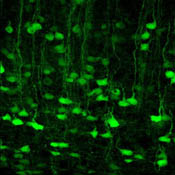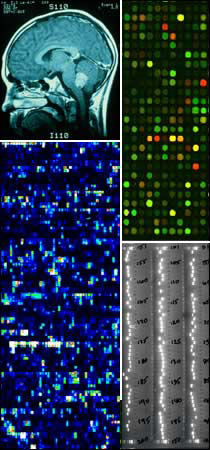Gene Expression
Skip secondary menu
Gene Expression resources are available to researchers as publicly accessible images and data or at reduced cost to NIH-funded
neuroscientists. These resources are co-funded by the NIH Neuroscience Blueprint.
GENSAT
NIH Microarray Consortium

GENSAT (Gene Expression Nervous System Atlas) involves the large-scale creation of transgenic mouse lines expressing green fluorescent protein (GFP) reporters or DNA recombinases in specific neural and glial cell populations. In each mouse line, expression of the reporter or recombinase is controlled by promoter elements derived from a bacterial artificial chromosome (BAC) containing a specific gene of interest, in order to mimic the gene’s expression pattern. To date, over 1,000 transgenic BAC-GFP reporter mouse lines have been generated. Many of these lines have proven to be extremely valuable in experiments requiring identification of specific cell populations and details of cellular morphology. Furthermore, each of these lines is a unique reagent that provides important data regarding the potential utility of its specific BAC targeting vector. In collaboration with the NIMH Intramural Program, GENSAT is also generating BAC-Cre recombinase driver lines to serve as tools for cell-specific genetic manipulations in the CNS. Approximately 30 fully characterized BAC-Cre recombinase lines have been created so far, targeting selected neuronal or glial populations in the brain and spinal cord (also see PMID: 17855595).
The BAC-GFP expression data and mouse brain images are available to the public in on-line, searchable databases (see weblinks below). Since the transgenic BAC mouse lines are powerful tools for neuroscience research, GENSAT distributes the mouse strains generated for the project via the Mutant Mouse Regional Resource Center (MMRRC). Over 700 BAC-GFP reporter mouse lines have been placed in the MMRRC repositories since the beginning of the project and are available for a small processing fee. Furthermore, as of January 2009, 22 BAC-Cre recombinase driver lines are available and more lines are on the way. Researchers can nominate genes for the GENSAT project by completing an on-line gene nomination form at http://www.gensat.org/GeneNominationForm.jsp. In addition, researchers can register interest for specific BAC-Cre recombinase diver lines currently in development at http://www.gensat.org/CrePipeline.jsp.
Related Sites:
BAC Transgenic Mouse GENSAT Database www.gensat.org/index.html
Mutant Mouse Regional Resource Centers www.mmrrc.org (select major collection ‘GENSAT’ and mutation type ‘Transgenic (cre)’ or ‘Transgenic (BAC)’)
In Situ Hybridization GENSAT Database www.stjudebgem.org/web/mainPage/mainPage.php
Submission of gene nominations for the generation of BAC-GFP reporter and BAC-Cre recombinase mouse lines http://www.gensat.org/GeneNominationForm.jsp.
NCBI GENSAT Database www.ncbi.nlm.nih.gov/projects/gensat
Contact:
Dr. Laura Mamounas, Program Director, NINDS
Dr. Ned Talley, Program Director, NINDS
Dr. Amelie Gubitz, Program Analyst, NINDS
NIH Neuroscience Microarray Consortium 
 The NIH Neuroscience Microarray Consortium provides gene expression profiling and SNP genotyping services on a fee-for-service
basis to investigators who are engaged in neuroscience research and have active funding from one of the 15 NIH Neuroscience Blueprint institutes and centers.
The NIH Neuroscience Microarray Consortium provides gene expression profiling and SNP genotyping services on a fee-for-service
basis to investigators who are engaged in neuroscience research and have active funding from one of the 15 NIH Neuroscience Blueprint institutes and centers.
The NIH Neuroscience Blueprint established a consortium of four centers to provide NIH-funded neuroscience investigators with the opportunity to further their research through the use of microarray technologies. The microarray consortium provides investigators with expert advice and access to state-of-the-art technologies for gene expression (activity) profiling and SNP genotyping (identifying DNA sequence variations). All of the data generated by the consortium is made publicly available through a web database. The four centers in the consortium are located at the University of California, Los Angeles (UCLA), the Translational Genomics Research Institute (TGen) in Phoenix, AZ, Yale University in New Haven, CT, and Duke University in Durham, NC. Several different technology platforms and laser-capture microdissection services are available through
Related Site
The NIH Neuroscience Blueprint
NIH Neuroscience Microarray Consortium
Contact:
Elizabeth Salomon, NIH Neuroscience Microarray Consortium Coordinator
Last updated January 26, 2009




